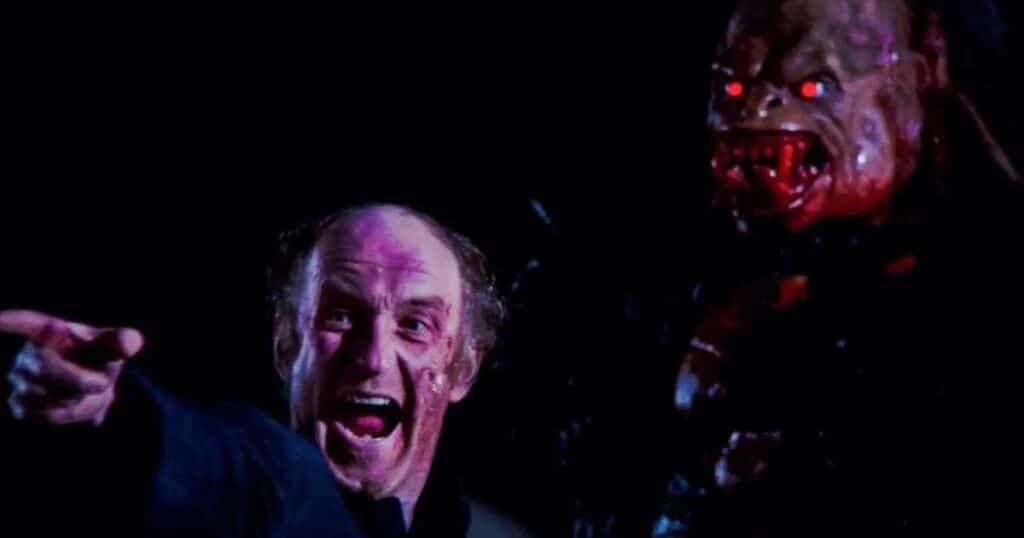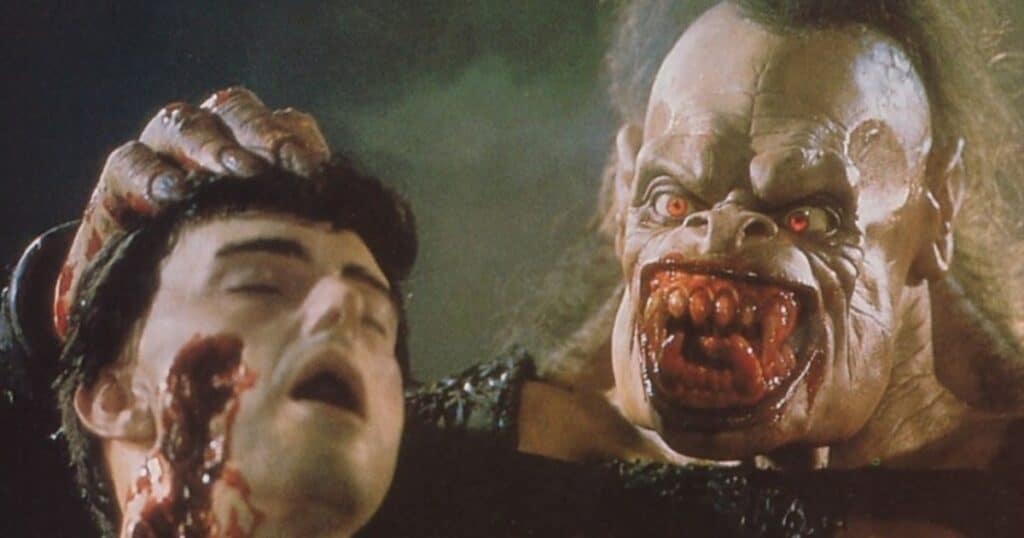
The Rawhead Rex episode of WTF Happened to This Horror Movie? was Written by Emilie Black, Narrated by Adam Walton, Edited by Juan Jimenez, Produced by Lance Vlcek and John Fallon, and Executive Produced by Berge Garabedian.
The 1980s were a period of overabundance in culture and films; it’s a period most remember as being colorful, loud, and filled with bright personalities on television and in film. This is an exaggeration created through media for the sake of a glossy reality being depicted. In fact, the 1980s were very… brown. And Rawhead Rex (watch it HERE) is basically the cinematic realization, if that makes sense. Let’s explain this:
Most people remember all the colorful fashion, the flashy looks, the pretty people, and horror films like The Monster Squad, Chopping Mall, and even Evil Dead, which were fairly brightly colored horror films with varying levels of the blood being used. Then there were movies like Rawhead Rex where people look more like your next-door neighbor growing up; there’s just about not a single bright color seen in clothing or décor, cars aren’t fast or fancy, and the food looks like the stuff you’d have at home. It just looks incredibly normal, making a film that comes out of the norm for the usual nostalgia crowd. What does attract the attention are the special effects, the church windows, and how almost normal everything is, and that’s the point, really.
The story here is that of a writer who brings his wife and kids to the Irish countryside for a vacation, where he also wants to do research for an upcoming book about legends and myths. Soon, a beast awakens nearby and starts a rampage against the locals and visitors. Most of the film centers on writer Howard Hallenbeck with multiple villagers being thrown into the mix seemingly as beast fodder. The beast in question is the titular character, Rawhead Rex, a beast so legendary it has its portrait depicted in a church window.
Clive Barker wrote this film’s screenplay based on his own short story published as part of Books of Blood Volume 3, which was also turned into a graphic novel. The film itself has a few changes from the short story, but given that those were made by Barker himself, it’s basically a non-issue for most of his fans. This cinematic version of the story here is something that should have grabbed the attention more and had more of an impact on horror fans, especially considering the practical effects used for the monster. With the pedigree behind the story and the adaptation efforts, what went wrong? Why does Clive Barker himself hate the film? Well, the script he wrote kept close to the short story as much as possible, but where the Master of Horror had issues were the acting and the beast design.
The acting is easy to see why; it’s not the best, but it’s also not as bad as it could have been. As for the beast, the monster, the titular character, Barker, took it badly that he was designed as an ogre or giant human-like creature, something that could have easily been a deformed human. His original idea for the beast was much more in line with some of his own art, with the creature being much more phallic in look, 9 feet tall, and with a face that looked like raw meat, something that would have been gruesome and fascinating, but also costly to produce. This monster design would have, of course, caused issues with ratings and distribution, so while his gripe is understandable, the need to release the film in a world that was more limited than it is now most likely led the filmmaker and producer toward a more ogre-like being.
Ratings these days are less and less important, but back then, a film’s age rating could make or break a film’s capacity to be profitable. Getting a high age rating back then would mean fewer theaters would carry the film, and then it would not play as well on television. The video store world was not all that old yet, the boom was beginning, but the reach was still limited. Also, the idea of a phallic monster on a regular television station or cable station back in the late 1980s seems like a far-fetched idea. The monster design had to be adapted to the film’s needs for distribution, something that was limited by outside forces. These days, there is a high chance that one of the many streaming platforms would take such a monster on and would even proudly display it as a shock factor and marketing device.

As mentioned before, the special effects for the creature were practical, giving the film a bit of a chance with most horror fans. However, the lack of budget led to a limited time to develop the creature’s look and how its makeup would be done and applied. In the end, the monster look was made from a suit and a single latex piece mask, something that can easily be seen in the film with a few sequences where the mask even seems to lift off the face of the actor underneath. This actor, Heinrich Von Schellendorf, who was only 19 then, was given two months to train in preparation for the film and the physical demands of the part. In a different world, or perhaps with a different budget, actor Peter Mayhew would have been Rawhead Rex as he was offered the part, but there was not enough budget to offer his salary, something he more than deserved given his experience in monster suits. Von Schellendorf did what he could with what he had, giving the public a decent creature in how it moved, but clearly something of a limited performance.
As for the rest of the cast, their performances could have been better. Something feels off throughout the film, and the only memorable performance outside of the creature was David Dukes as Howard Hallenbeck, and what made it memorable is not just the positive. The performance Dukes gives seems to be indicative of issues with either the script or the direction. The rest of the cast is almost interchangeable in their performances, not exactly giving the viewer much to write home about. On a side note, playing the Hallenbeck son Robbie is a very young Hugh O’Conor who is credited as “introducing” even though this was not his first part. His work here is ok, considering how very little he has to do for most of the film. Working with him in most of his scenes is Cory Venus Lunny, who is now more known for her music work as a violinist and music arranger.
Her work here hinges on her being adorable and easily put in danger, which viewers will see well before her onscreen parents. Overall, the cast here is decent at times, wooden at others, and seemingly completely lost sometimes. This does bring things back to director George Pavlou whose second movie this was, and who went on to direct two more features and two shorts. This leads us to believe that perhaps he may not have been the best choice here.
The production hired director George Pavlou with a budget of $2.5 million in place, but after the production had started, the budget dropped to a measly $1.5 million, which the producers hid from the director for as long as they could, something that may have led to some of the odd decisions behind the scenes, the cut in costs left and right, and ultimately affected the final look of the film. On that $1.5 million budget, the film got a theatrical release which put it on 203 screens, allowing it to have a small theatrical run and make a grand total of $1.8 million during its first three days.

This isn’t entirely bad, but the film didn’t exactly have legs after that, and its total take was not much higher. Between the low budget for the production, the low budget for marketing, a figure impossible to find now, and the fact that it already was starting with a limited appeal to audiences, Rawhead Rex was a bit doomed. Now, add to that the other films available in theaters that weekend, and it’s easy to see why the film made so little money. These films, in order of box office success and descending, were: Blind Date, Lethal Weapon, Platoon, Tin Man, Burglar, A Nightmare on Elm Street 3: Dream Warriors, Hoosiers, Mannequin, Outrageous Fortune, and Angel Heart.
Two of these were major players for horror fans’ money, and some of the others were just so massive it would have been difficult for any movie to make any money while sharing the multiplexes with them. To make sure the film had no staying power, the next few weeks saw the added releases of Police Academy 4: Citizens on Patrol, The Secret to My Success, The Aristocats, Raising Arizona, and a few more to the top ten of the box office. This was some fierce competition and let’s be honest, the 1980s in theaters were a brutal time for anything without any name recognition, big cast, or awards appeal. This is one of those things that many films came up against and something that Rawhead Rex had no chance against if we are honest with the value of the film.
When it comes to horror fans, though, a weak box office is not something that will stop them from watching the film, so video rentals of this were a good place to find it, as well as some rare cable appearances. Through the years, the film became harder and harder to find, but due to its reputation as a so-bad-it’s-good film or a low, low-budget monster film, and thanks to magazines and word of mouth, people wanted to see this. It got a few releases through the years here and there, most of them entirely too difficult to track down. Its German DVD release looked fantastic, and it eventually got a blu ray release as well as a 4k UHD release made from a brand-new scan of the original film negatives. While the film looks great, the higher definition here does not necessarily help it. The effects have issues, and the film itself looks a bit grainy in the new release, but it’s as good as it’s going to get for fans. However, the general public has pretty much forgotten this film with no interest in finding it again, it seems. The film’s limited appeal is something that hurts its sales to this day.
This is a prime example of something that had so much potential and was squandered. The fact that it comes from a Clive Barker short story gives it incredible pedigree, but the fact that its creator himself hates the film makes it more difficult to want to watch it. Changes made from the short story to the script, as mentioned before, were easier to live with given his involvement, but his dislike of the final product due to monster design issues is something that is hard to bypass for some of his fans. Another change fans of the short story have had issues with through the years is the change in the ending.
It went from Hallenbeck, named Ron in the book and Howard in the film, using the talisman against Rawhead Rex, which then allowed the people to kill him, something that was not quite so in the film where Hallenbeck’s wife is the one using the talisman against the monster, but he is not fully ended this way. This leads to a potential for a sequel, presumably, something the short story did not see a need for, but films have been trying to leave it as an open possibility for ages now, including in the 1980s. There are deep dives into why this is all over the web, and some of them show it as using her femininity against this toxic representation of masculinity while also not having a fully feminine representation of being as would be traditional to use in a folk tale. This is something that some will see as looking too deep into the story, while others will see it as a reason why the film as a whole ultimately doesn’t work.
Of course, there is much more to this than just a battle of the masculine versus feminine with the church at its center, but it is a decent analysis of the story here. The film does seem to both use this and downplay it, making it seem like it doesn’t fully know what it wants to achieve while working from a story by a master who constantly puts more themes and depth into his stories than general audiences expect. Barker’s work is strong in most of his stories, and there is a lot to unwrap and dig through in his work, Rawhead Rex included. The story here is a good one in its short print form, one worth checking out and analyzing while the film itself isn’t entirely bad, it has enough issues to make it easy to bypass or avoid. Perhaps, with the current reboot, requel, remake, and legacy explorations of films from the past, Rawhead Rex could see itself re-explored and given a proper adaptation, phallic 9-foot tall raw meat-faced monster included.
A couple of the previous episodes of WTF Happened to This Horror Movie? can be seen below. To see more, head over to our JoBlo Horror Originals YouTube channel – and subscribe while you’re there!
Originally published at https://www.joblo.com/rawhead-rex-1986-wtf-happened-to-this-horror-movie/


